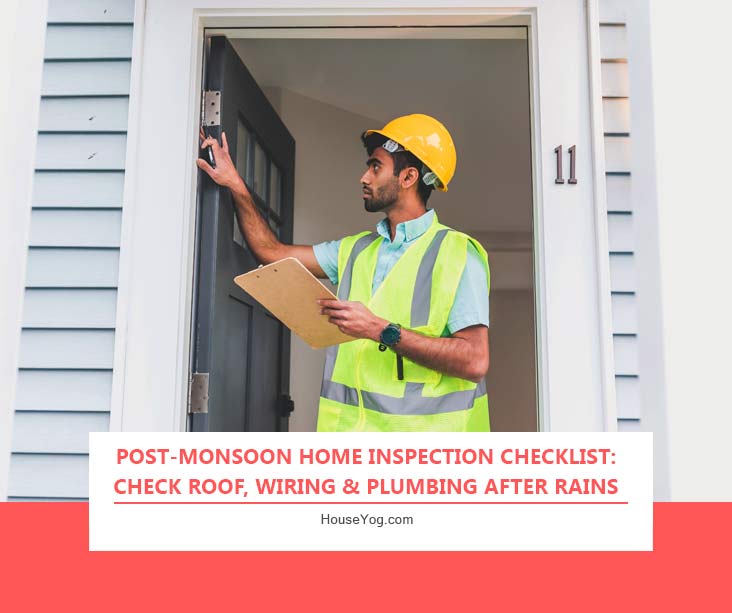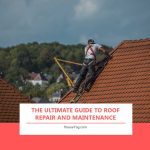Monsoon brings freshness and greenery—but it can also leave behind hidden home damage. Roof leaks, damp walls, wiring issues, or plumbing blockages often show up after the rains. A post-monsoon home inspection helps you catch and fix these issues early. If you wait too long, small issues turn into major repairs. That’s why a post-monsoon home inspection is essential. Whether you live in an apartment, a bungalow, or a villa, this checklist will help you identify and repair rain damage early, saving you from expensive damage repair later.
This guide walks you through a detailed home damage check after rain, covering structure, wiring, plumbing, and interiors, with practical repair tips and cost insights. We’ll also suggest approximate costs, real-world scenarios, and tips to help you decide when you need an expert.
Exterior & Roof Inspection
Your home’s first line of defence against rain damage is the roof and exterior walls. After monsoon, inspect every surface exposed to water—roof tiles, parapets, and drainage points—to detect early signs of leaks or structural fatigue.
1. Roof & Terrace
- Check for ponding water, cracks, and missing tiles.
- Inspect roof junctions, parapets, and drainage slopes.
- Waterproof membranes may show peeling or blistering.
Why: Even minor leaks will seep into walls and ceilings.
Potential Repair Costs (Indicative): Rs. 80– Rs. 200 / sq ft for re-waterproofing or resurfacing (depending on material and region).
Tip: Use elastomeric coatings or liquid-applied waterproofing for flat terraces.
2. Gutters, Downspouts & Drainage
- Clear leaf debris, mud, and blockages.
- Check that downspouts carry water well away from the foundation.
- Inspect sewer lines or stormwater pipes for leaks or cracks.
Why: Blocked or damaged drains cause overflow, seepage, and foundation dampness.
Repair Estimate: Clearing and patching cost ₹Rs. 200–₹Rs. 800 per segment, depending on location and height.
3. External Walls & Facade
- Look for damp patches, efflorescence, flaking paint, or vertical cracks.
- Inspect external cladding, gutters, window sills, and balcony edges.
- Check sealants around windows/doors for failure.
Why: Water ingress leads to structural weakening and mold issues.
Repair Cost: Replastering + waterproof coat may cost ₹Rs. 40–₹Rs. 120 / sq ft, depending on severity.
Structural & Foundation Checks
After heavy rains, small cracks can hint at deeper foundation issues. A quick post-monsoon structure check helps you spot cracks, settlement, or dampness that may weaken your home’s stability over time.
1. Crack & Settlement Inspection
- Inspect walls, beams, lintels, and corners for horizontal, diagonal, or stair-step cracks.
- Measure new cracks vs old ones; note spreading.
Why: Foundation shifts and soil subsidence after heavy rains cause structural damage.
When to Call Expert: If cracks exceed 5 mm or show movement over time.
2. Plinth & Basement Areas
- Check basement floors, internal walls, and slabs for dampness or seepage.
- Look for bulging or bulge cracks at plinth level.
Why: Rising damp or waterlogging foundation can affect the entire structure.
Electrical & Wiring Audit
Humidity and rainwater can silently affect electrical systems. A home wiring inspection after monsoon ensures safety—preventing short circuits, tripping, or corrosion in switchboards, MCBs, and junction boxes.
1. Switchboards, Panels & MCBs
- Inspect for rust, water stains, loose covers, or corrosion.
- Test circuit breakers and residual current devices (RCDs).
2. Outdoor & Exposed Wiring
- Look for insulation damage, exposed wires, or loose connections.
- Ensure conduits are sealed and no water is entering junction boxes.
3. Appliances & Fixtures
- Test light fixtures, fans, and outdoor sockets.
- Check for flickering lights or short circuits.
Why: Moisture intrusion can cause short circuits, tripping, or fire risk.
Repair Cost Estimate: Rewiring or change of switches may cost ₹Rs. 100–₹Rs. 300 per point; junction box repair or panel cleanup may range ₹Rs. 1,000– Rs. 5,000, depending on complexity.
Plumbing & Drainage Inspection
Monsoon floods often stress your plumbing system. Check for pipe leaks, low pressure, or blocked drains to prevent post-rain dampness and bacterial growth inside your walls or floors.
1. Internal Leaks & Pipe Joints
- Inspect all taps, faucets, showers, and concealed pipes.
- Watch for dripping or weak pressure.
2. Bathroom & Kitchen Tiles / Grouting
- Check for cracked tiles, missing grout, or loose areas.
- Look for mold or discolouration around edges.
3. Sewage & Waste Disposal Pipes
- Flush and test sewage lines, traps, and P-traps.
- Ensure clean waste flow and no blockages.
Why: Plumbing breakdowns lead to hidden dampness and mold propagation.
Repair Estimate: Pipe joint repair or replacement may cost ₹Rs. 300– Rs. 800 per point; re-grouting or tile adjustment ₹Rs. 20–₹Rs. 60 / sq ft.
Interior Checks: Walls, Ceilings & Floors
Moisture trapped inside can ruin interiors long after the rains are gone. Inspect ceilings, walls, and floors for stains, bubbles, or mold as part of your post-monsoon interior inspection checklist.
1. Ceilings & False Ceilings
- Spot water stains, peeling paint, bulges in plaster, or sagging panels.
2. Interior Walls & Paint
- Note damp patches, mold growth, and wallpaper peeling.
- Check for paint blistering or efflorescence.
3. Flooring & Tiles
- Inspect tile joints, grout lines, broken tiles, or loosened slabs.
- Look for unevenness where the subfloor may have shifted.
Why: Post-monsoon humidity damages interiors and aesthetics.
Repair Estimate: Touch-up painting ₹Rs. 10- Rs. 25 / sq ft; replaster + paint ₹Rs. 40–₹Rs. 120 / sq ft, depending on finish.
Windows, Doors & Woodwork Inspection
Humidity swells wooden elements, causing jamming or decay. After the monsoon, inspect all doors, windows, and furniture for warping, mold, or termite damage to maintain durability and aesthetics.
1. Window Frames & Sashes
- Check for water stains, frame warps, and gaps in seals.
- Test smooth operation and alignment.
2. Door Frames, Panels & Locks
- Inspect the underside of doors for swelling or sticking.
- Check locks, hinges, and gaps.
3. Wooden Furniture & Ceilings
- Inspect for mold growth, warping, and termite signs (hollow sound, tiny holes).
- Move furniture slightly away from damp walls for ventilation.
Why: Moisture enters via these weak links, damaging furniture and causing rot. You may like to check out our detailed guide on how to protect furniture from humidity and termites in the rainy season.
HVAC, Ventilation & Air Quality
High humidity creates stale air and mold. Clean filters, ensure ventilation, and use dehumidifiers where needed. A well-ventilated home dries faster and prevents post-rain dampness.
- Clean and service HVAC filters, ducts, and grilles.
- Ensure exhaust fans in bathrooms/kitchens are working.
- Use dehumidifiers or desiccant packs in enclosed spaces.
- Check attic or loft ventilation for stagnant, damp air.
Why: Good ventilation helps dry residual moisture and prevents mold or mildew.
Final Walkthrough & Photo Documentation
Once your inspection is complete, document every issue with photos. This helps prioritise repairs, manage costs, and maintain a reference record for yearly home inspection after the rains.
- Walk through every room with a checklist, and mark issues.
- Take photos before and after repairs to track progression.
- Prioritise repairs by urgency and cost.
- Maintain a log or schedule for yearly or seasonal follow-up.
Why: Documentation helps you negotiate repairs, insurance claims, or future maintenance scheduling.
Summary and Key Takeaway
A robust post-monsoon home inspection prevents small rain-related issues from becoming expensive structural or electrical disasters.
By systematically checking roofs, walls, wiring, plumbing, interiors, and ventilation—especially in Indian monsoon zones—you can protect both your home and your wallet.
If you’re planning repairs, renovation, or home upgrades, connect with Houseyog’s experts. We can help you with detailed structural assessments, design fixes, and durable solutions to keep your home safe year after year.
FAQs – Post Monsoon Home Inspection & Repair
Do your inspection within 1–2 weeks after heavy rains end. This helps you detect leaks or dampness before mold or structural damage sets in.
You can handle visual checks for cracks, leaks, or switches. But for foundation, wiring, or waterproofing, hire a professional home inspector or civil engineer.
A professional home inspection after rains for a 2BHK or 3BHK typically costs Rs. 3,000–Rs. 10,000, depending on the city, scope, and home size.
Start with your roof and drainage system, since most water damage originates there and gradually affects walls and interiors.
Once every monsoon season is ideal. You can also schedule a smaller mid-season check if your area receives heavy or prolonged rainfall.






